February 20-28th, 2017 (edited at the end of the cruise)
The zodiacs are really what made our Antarctic Expedition possible. They are what gave us access to the islands and the ice, and they provided essential backup support for the snorkelers and divers. And at times they provided a considerable degree of excitement and quite an adrenalin rush!
 Heading for a landing on mainland Antarctica
Heading for a landing on mainland Antarctica
When not in use the zodiacs were lashed to the rear deck, and sometimes the top one filled with ice and snow. They were lowered into the water by a crane, with its driver already on board. We embarked via a steep gangway over the side of the Polar Pioneer.
Before we left Ushuai, and while in Antarctica
Our zodiacs were in essence inflatable rubber boats with a capacity of 10 passengers and driver. Propulsion was a 60 horsepower Yamaha outboard motor. The sides and bow were inflated tubes about 50 cms in diameter, with rings attached through which a rope was threaded … useful for carrying the things, holding on to when bouncing on the swell, and for lashing the zodiac to the gangway. The rubber was heavy duty stuff, not your average rubber tube for playing at the beach. Thank goodness - we were often manoeuvring through masses of brash ice and small ice flows! It was also very reassuring to be told that the whole thing is compartmentalised so if one or two were punctured, we’d still float. The floor was reinforced below with aluminium, and there were heavy duty rubber mats that provided a non-slip surface. Both were invaluable as the former provided added protection from all the lumps of ice, and the non-slip helped, mostly, with embarking and disembarking the zodiac.
We hoped this one’s name was not an omen!
Access to the zodiac from the Polar Pioneer was via a steep gangway, maximum of three people at a time please. One of the Russian crew was stationed at the bottom of the gangway on a platform with a nonslip rubber mat. Another crew or expedition leader was in the zodiac to provide further support using a sailor’s hand grip: your fingers gripping the other’s wrist, so if one lost their grip, the other still had a grip. Last step on the gangway had to be on the rubber mat. The next step was onto the top of the zodiac tube. Now this could be tricky, as one moment you might be stepping down on to it, then the next swell has come and the zodiac has risen a metre. Finally, step three was onto a conveniently placed wooden box in the zodiac, and a fourth on to the zodiac floor. You then sit on the tube, facing in, and all shuffle down towards the stern. We all got pretty good at it!
Zodiac access – an essential ritual
It could be a very wet process as the swell tosses the zodiac here and there. But whenever on the zodiacs we wore gumboots and waterproof pants and heavy duty jacket, so the wet was no problem. Similarly, when travelling in the zodiacs in open water it could get very wet, with spray blowing over us. We had to abort one off-shore trip just after landing as a squall came in and we had a very impressive, bouncing trip back to the boat, with spray going everywhere. It was quite an adrenalin rush, and I was sure when the spray came over us that it had frozen in the air between the sea and my face as it stung! It also tasted deliciously salty.
Heading off on an adventure
Just looking
Disembarking from the zodiacs was pretty straightforward, in principle. The bow beaches on land or ice, you shuffle up to the bow, face the stern or sea and swing one leg over the tube into the water and stand on it. The other leg follows. Sometimes the water is calm, sometimes choppy. Sometimes you are stepping onto gravel and all is well, other times you are stepping onto rocks which might be slimy. The one variation was getting Krista’s short legs over the tubes: a degree of hoisting or pushing and shoving was sometimes needed. Generally, the first off has the easier time as the zodiac is laden and this helps dampen motion due to waves.
Some disembarkations are easy and sheltered!
Amongst the ice the zodiacs were a wonderful calm platform for viewing and photographing wildlife and ice flows. The presence of a large amount of ice and icebergs really filtered out the ocean swell and we generally had calm, very reflective conditions. We had some wonderful times just being driven around in the zodiacs, checking out seals asleep on an ice flow, being awed by the colours in the ice, following porpoising penguins or cruising seals. A couple of times icebergs prevented the Polar Pioneer from going as far into a bay as was planned for a landing. Then we simply cruised around the obstacles in our zodiacs, and had many a bonus experience with the wildlife.
Cruising around amidst ice flows and wildlife was superb
Getting off the zodiac and back onto the boat also has its moments, especially in a strong swell. The ship does not move much with the swell (except when it makes folk seasick in open waters!). But the little zodiacs basically sit on the top of the swell. So its vertical position relative to the gangway can be constantly changing, and it is sometimes pointing downwards, sometimes upwards. The crewmen lash the zodiac to the gangway, which at least keeps it close to it. We then disembark from the bow: stand and give one hand to the crew member on the zodiac who helps you up onto the tube via the little wooden box, give your other hand to the crewman on the gangway and step down – or up – on to bottom platform of the gangway, always the bottom platform as it has non-slip matting, and then the easy bit: you walk up. Again, last one off has the biggest thrill!
No one got hurt in any of these processes. No one fell out of one, and no one got wet either, other than from spray. I was extremely impressed with the Russian crew who helped us on and off the zodiacs, and with the crew members and expedition leaders who navigated the things on choppy sea or through ice packs.
(Added at the end of the trip: Our last zodiac trip offshore to catch the plane back to Punta Arenas was very rough and three or four people “fell” into the zodiac I was on when the swell changed the location of the steps! Again, no injuries, nor serious loss of dignity!)
Safety was paramount, and the checks and balances in use simple and impressive. There was a tag board on the ship near the gangway. If you go off ship, you have to turn your tag over so it reads “off”, and when you come back on board you had to turn it back to “on”. It was disallowed to turn someone else’s tag for them! After a landing, the Polar Pioneer would not move until all tags read “on”. Everyone had to wear a life jacket in the zodiacs. When were out of the zodiac and on shore, we took those off and placed them in large bags at the landing site. So, the same number of life jackets were in the bags as people on shore. The last zodiac would not return to the ship if there were any life jackets in the bags.
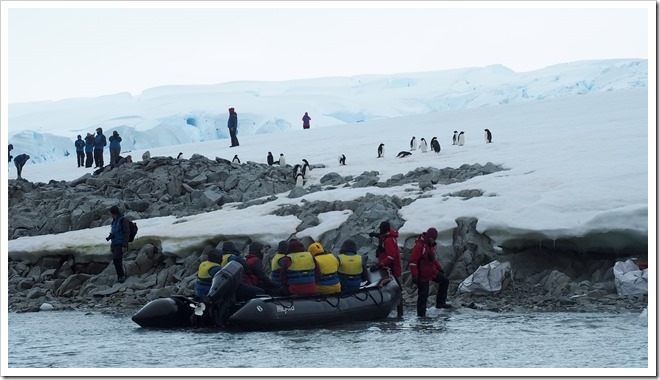 Disembarking on land … note the bags for life jackets
Disembarking on land … note the bags for life jackets
Finally, the zodiacs were also used as the on-water base for the scuba divers. And there was an alternative form of transport: kayaks! The scuba divers and kayakers were each a bit of an exclusive mob, or so we felt, and to find yourself at a meal table occupied by them was a bit intimidating!
 Scuba divers … more gear than people, but I’m sure we saw more than they did!
Scuba divers … more gear than people, but I’m sure we saw more than they did!
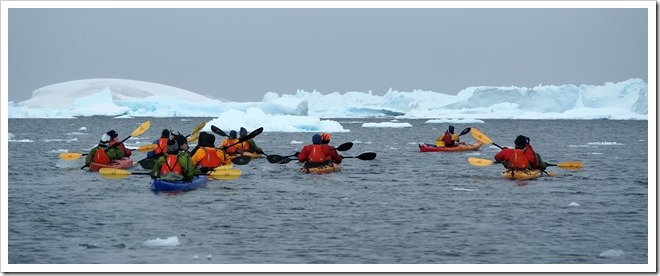 Alternative transport … a lot of hard work, especially against the wind!
Alternative transport … a lot of hard work, especially against the wind!
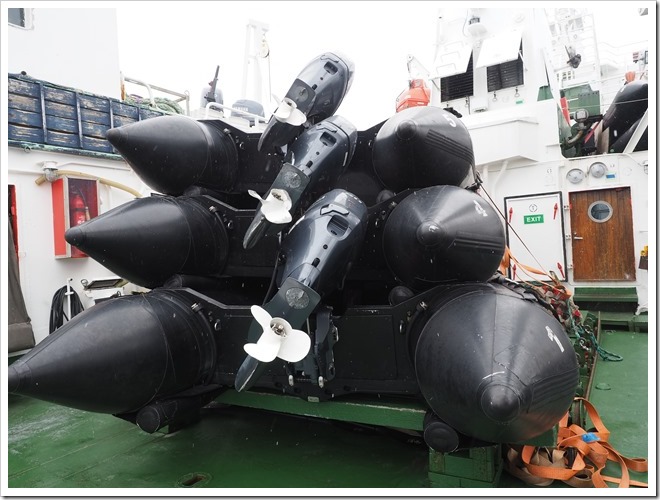
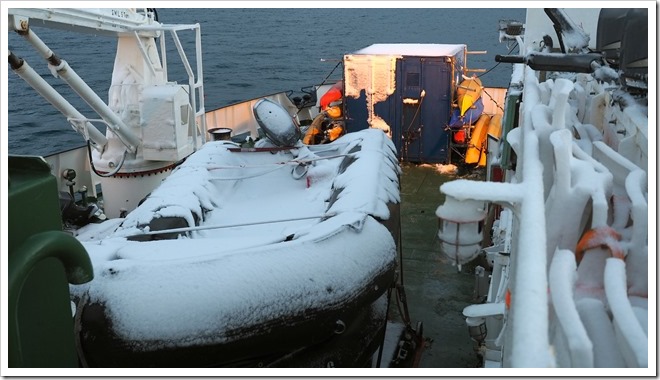
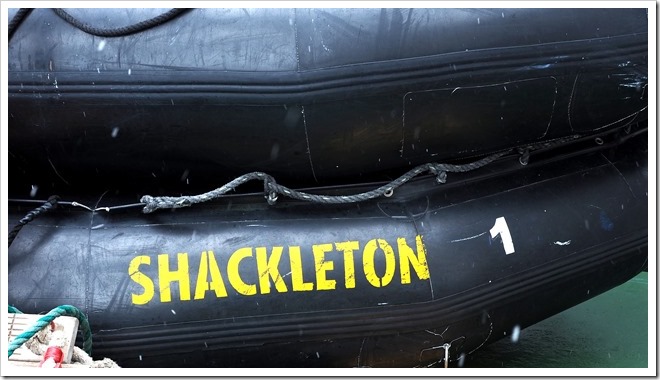
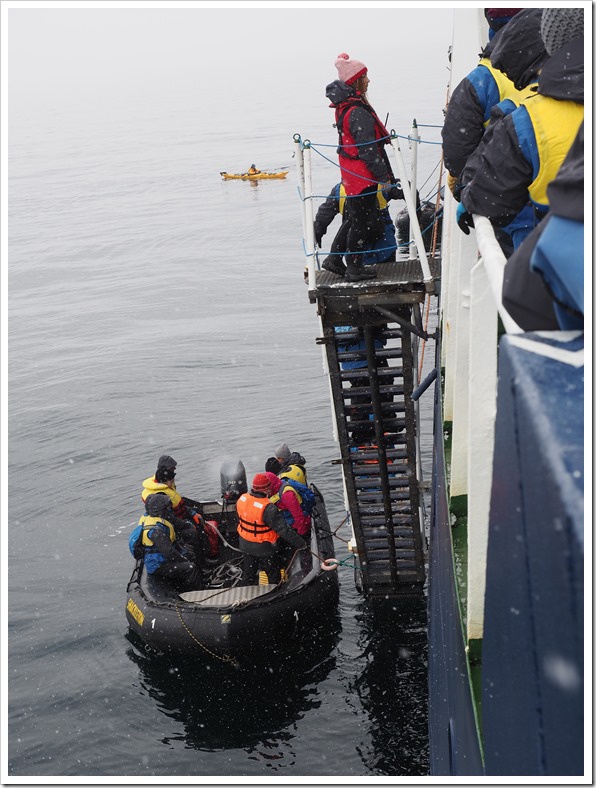


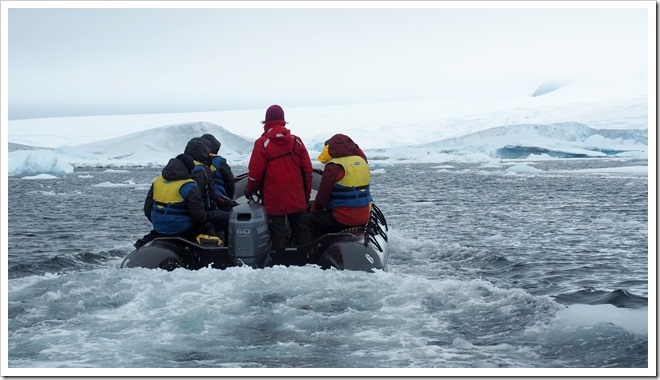

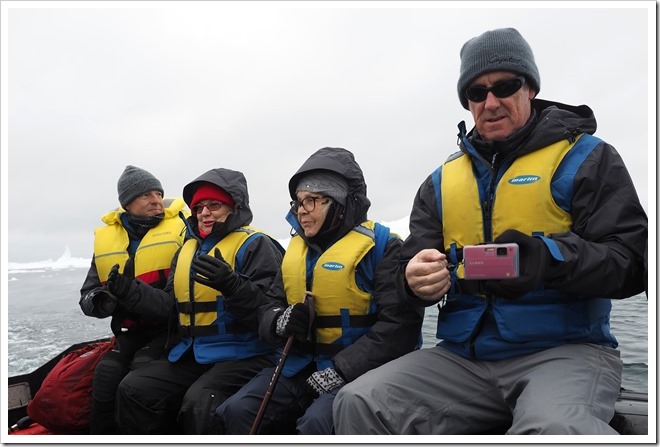


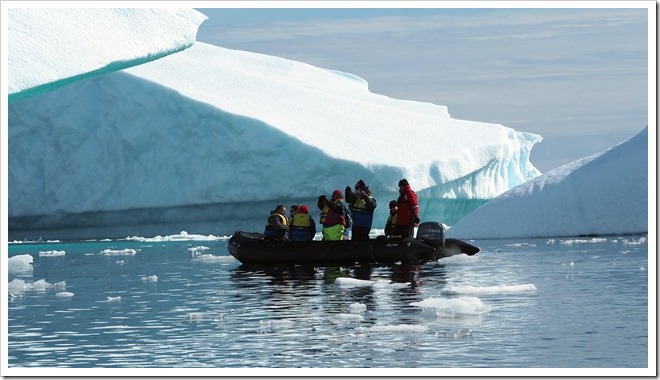

No comments:
Post a Comment